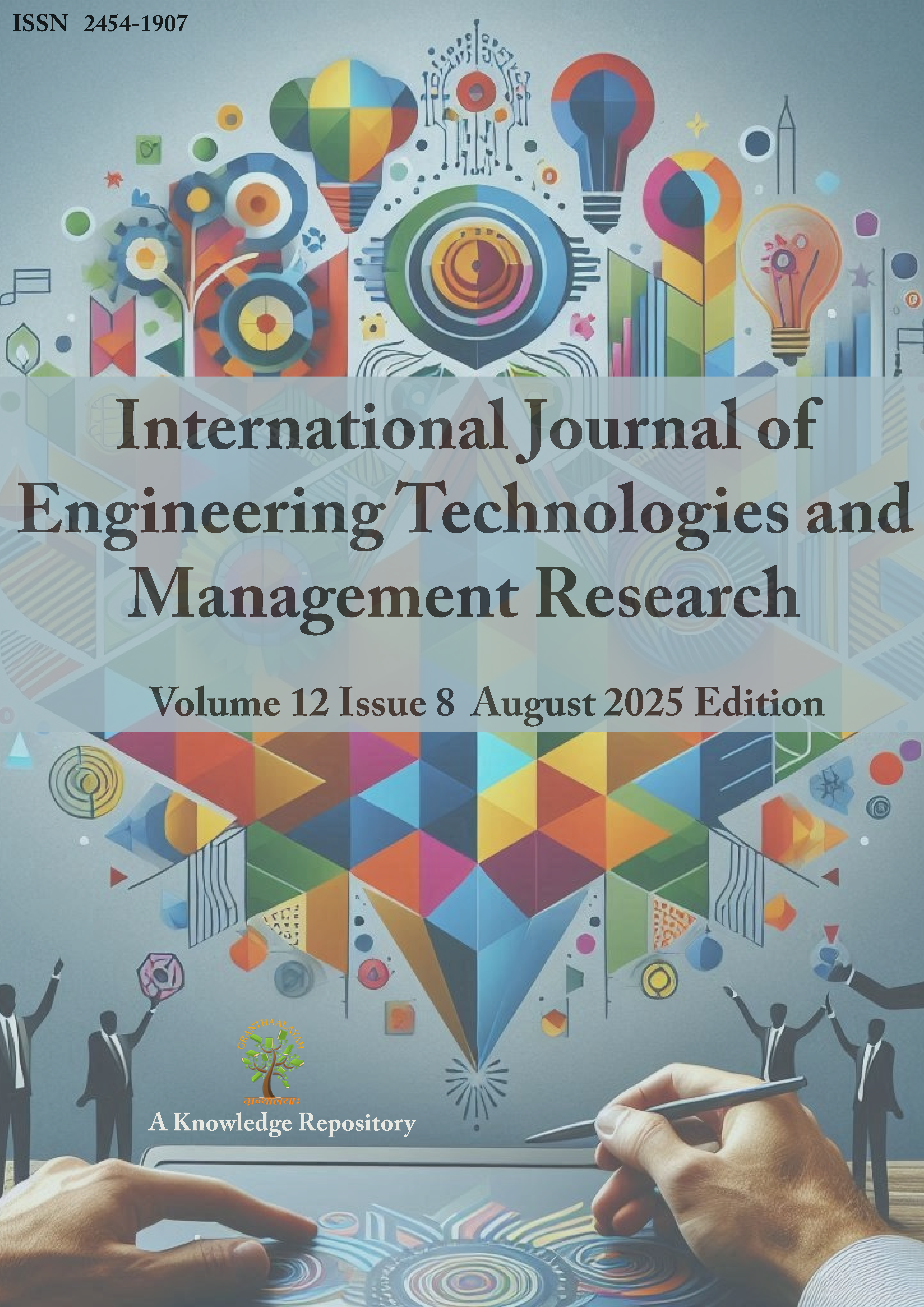E-SENTIMENTS AND STOCK MARKET PREDICTION: A BIBLIOMETRIC ANALYSIS
DOI:
https://doi.org/10.29121/ijetmr.v12.i8.2025.1661Keywords:
E-Sentiments, Stock Market Prediction, Bibliometric Analysis, Sentiment Analysis, Machine LearningAbstract
Purpose: The purpose of this study is to conduct a bibliometric analysis of research related to e-sentiments and stock market prediction. It aims to map the evolution of the field, identify key trends, and examine the methodologies used in sentiment-based stock market forecasting. The study also identifies influential authors, institutions, and countries contributing to the development of this research area.
Design/Methodology/Approach: This research employs bibliometric analysis through tools such as the biblioshiny interface from the bibliometrix package in R-studio and VOS viewer software. The analysis includes data from publications between 2000 and 2025, focusing on citation networks, author collaborations, keyword co-occurrences, and the geographical distribution of research. The study provides insights into major trends, methodologies, and the growth of the e-sentiment analysis field in stock market prediction.
Findings: The findings show significant growth in the number of publications, particularly from 2020 onwards, with a peak in 2024. Key contributors to this field include prominent journals like Expert Systems with Applications and IEEE Access, as well as leading authors such as Liang, C., and Ma, F. Research output is heavily concentrated in China, India, and the United States. The integration of machine learning techniques such as Long Short-Term Memory (LSTM) networks and Support Vector Machines (SVM) has been crucial in enhancing prediction accuracy. Despite the promising advancements, challenges like data quality, noise, and ambiguity in sentiment signals remain.
Originality/Value: This study contributes to the understanding of e-sentiment analysis by providing a comprehensive overview of its evolution, identifying emerging trends, and highlighting the gaps in current research. It offers valuable insights into how sentiment analysis can enhance stock market prediction models by incorporating emotional and psychological factors that traditional models often overlook.
Downloads
References
Anggraeni, W., Yuniarno, E. M., Rachmadi, R. F., Sumpeno, S., Pujiadi, P., Sugiyanto, S., et al. (2024). A Hybrid EMD-GRNN-PSO in Intermittent Time-Series Data for Dengue Fever Forecasting. Expert Systems with Applications, 237, 110565. https://doi.org/10.1016/j.compeleceng.2025.110565
Azadmanesh, M., Ghahfarokhi, B. S., & Talouki, M. A. (2025). On the Local Convergence of ADAM-DPGAN with Simultaneous and Alternating Gradient Descent Training Methods. Expert Systems with Applications, 262, 110545. https://doi.org/10.1016/j.exsys.2025.110565
Bentaleb, D., & Khatar, Z. (2025). Multi-Criteria Bayesian Optimization of Empirical Mode Decomposition and Hybrid Filters Fusion for Enhanced ECG Signal Denoising and Classification. Computational Biology and Medicine, 184, 110265. https://doi.org/10.1016/j.cbmd.2025.110370
Brini, A., & Toscano, G. (2024). SpotV2Net: Multivariate Intraday Spot Volatility Forecasting Via Vol-of-Vol-Informed Graph Attention Networks. Journal of Financial Markets, 97, 15421. https://doi.org/10.1016/j.jfin.2024.110130
Campbell-Lendrum, D., Neville, T., & Schweizer, C. (2023). Climate Change and Health: Three Grand Challenges. Nature Medicine, 29(12), 1631–1638. https://doi.org/10.1038/s41591-023-02438-w
Cao, Y., Choo, W. C., & Matemilola, B. T. (2025). Value-At-Risk Forecasting Based on Textual Information and a Hybrid Deep Learning-Based Approach. International Review of Economics and Finance, 103, 104403. https://doi.org/10.1016/j.iref.2025.104403
Cao, Y., Liu, G., Luo, D., Bavirisetti, D. P., & Xiao, G. (2023). Multi-Timescale Photovoltaic Power Forecasting Using an Improved Stacking Ensemble Algorithm Based LSTM-Informer Model. Energy, 283, 110420. https://doi.org/10.1016/j.energy.2023.110535
Chen, Y., Ba, S., Yang, Q., Yuan, T., Zhao, H., & Zhou, M. (2021). Efficiency of China's Carbon Market: A Case Study of Hubei Pilot Market. Energy, 222, 11234. https://doi.org/10.1016/j.energy.2022.114534
Chen, Y., Liu, X., Rao, M., Qin, Y., Wang, Z., Ji, Y., et al. (2025). Explicit Speed-Integrated LSTM Network for Non-Stationary Gearbox Vibration Representation and Fault Detection Under Varying Speed Conditions. Reliability Engineering and System Safety, 254, 120305. https://doi.org/10.1016/j.ress.2025.110765
Cui, X., & Niu, D. (2024). Carbon Price Point-Interval Forecasting Based on Two-Layer Decomposition and Deep Learning Combined Model Using Weight Assignment. Journal of Cleaner Production, 483, 230245. https://doi.org/10.1016/j.jclepro.2024.110267
Dong, F., & Li, Z. (2024). Analysis of Market Risk Volatility and Warning in the Carbon Trading Market. Journal of Cleaner Production, 452, 220289. https://doi.org/10.1016/j.jclepro.2024.110420
Dong, X., & Zhang, J. F. (2024). Heterogeneity of Regional Carbon Emission Markets in China: Evidence from Multidimensional Determinants. Energy Economics, 138, 115784. https://doi.org/10.1016/j.eneco.2024.110160
Gao, R., Cui, S., Wang, Y., & Xu, W. (2025). Predicting Financial Distress in High-Dimensional Imbalanced Datasets: A Multi-Heterogeneous Self-Paced Ensemble Learning Framework. Financial Innovation, 11(1), 50. https://doi.org/10.1186/s40854-024-00745-w
Huang, N. E., Shen, Z., Long, S. R., Wu, M. L. C., Shih, H. H., Zheng, Q. N., et al. (1998). The Empirical Mode Decomposition and The Hilbert Spectrum for Nonlinear and Non-Stationary Time Series Analysis. Proceedings of the Royal Society A: Mathematical, Physical and Engineering Sciences, 454, 903–995. https://doi.org/10.1098/rspa.1998.0193
Huang, Z.-C., & Sangiorgi, I. (2024). Forecasting Bitcoin Volatility Using Machine Learning Techniques. Journal of International Financial Markets, Institutions & Money, 97, 110543. https://doi.org/10.1016/j.intfin.2024.102064
Jianwei, E., Ye, J., & He, L. (2021). A Denoising Carbon Price Forecasting Method Based on the Integration of Kernel Independent Component Analysis and Least Squares Support Vector Regression. Neurocomputing, 434, 67–79. https://doi.org/10.1016/j.neucom.2020.12.086
Kim, H. Y., & Won, C. H. (2018). Forecasting the Volatility of Stock Price Index: A Hybrid Model Integrating LSTM with Multiple GARCH-Type Models. Expert Systems with Applications, 103, 25–37. https://doi.org/10.1016/j.eswa.2018.03.002
Kingma, D. P., & Ba, J. (2014). Adam: A Method for Stochastic Optimization. Computer Science, 1–15.
Kristjanpoller, W., Fadic, A., & Minutolo, M. C. (2014). Volatility Forecast Using Hybrid Neural Network Models. Expert Systems with Applications, 41, 2437–2442. https://doi.org/10.1016/j.eswa.2013.09.043
Leitao, J., Ferreira, J., & Santibanez-Gonzalez, E. (2022). New Insights into Decoupling Economic Growth, Technological Progress and Carbon Dioxide Emissions: Evidence from 40 Countries. Technological Forecasting and Social Change, 174, 110566. https://doi.org/10.1016/j.techfore.2021.121250
Li, J., & Hu, Y. (2024). Analysis on the Synergy Between Markets of Electricity, Carbon, and Tradable Green Certificates in China. Energy, 302, 115301. https://doi.org/10.1016/j.energy.2024.131808
Li, T., Yue, X., & Qin, M. (2024). Towards Paris Climate Agreement Goals: The Essential Role of Green Finance and Green Technology. Energy Economics, 129, 110431. https://doi.org/10.1016/j.eneco.2023.107273
Liu, J., & Zhang, Z. (2021). Forecasting the Volatility of EUA Futures with Economic Policy Uncertainty using the GARCH-MIDAS Model. Financial Innovation, 7, 1–19. https://doi.org/10.1186/s40854-021-00292-8
Liu, T., & Ma, X. (2022). A Stock Price Prediction Method Based on Meta-Learning and Variational Mode Decomposition. Knowledge-Based Systems, 252, 110876. https://doi.org/10.1016/j.knosys.2022.109324
Liu, Y. (2019). Novel Volatility Forecasting using Deep Learning – Long Short Term Memory Recurrent Neural Networks. Expert Systems with Applications, 132, 99–109. https://doi.org/10.1016/j.eswa.2019.04.038
Lv, T., & Tao, A. (2023). Significant Wave Height Prediction Based on the Local-EMD-WaveNet Model. Ocean Engineering, 287, 110934. https://doi.org/10.1016/j.oceaneng.2023.115900
Man, Y., & Zhang, S. (2024). Dynamic Risk Spillover and Hedging Efficacy of China's Carbon-Energy-Finance Markets: Economic Policy Uncertainty and Investor Sentiment Non-Linear Causal Effects. International Review of Economics & Finance, 93, 1397–1416. https://doi.org/10.1016/j.iref.2024.03.066
Massar, H., & Stergiadis, C. (2024). EMD-BSS: A Hybrid Methodology Combining Empirical Mode Decomposition and Blind Source Separation to Eliminate Ocular Artifacts from EEG Recordings. Biomedical Signal Processing and Control, 95, 110287. https://doi.org/10.1016/j.bspc.2024.106475
Nair, V., & Hinton, G. E. (2010). Rectified Linear Units Improve Restricted Boltzmann Machines. Neural Computation, 23(2), 607–611.
Ng, W. W. Y., & Zhang, Q. (2024). Improving Domain Generalization by Hybrid Domain Attention and Localized Maximum Sensitivity. Neural Networks, 171, 320–331. https://doi.org/10.1016/j.neunet.2023.12.014
Ouyang, Z., & Lu, M. (2023). Forecasting Stock Index Return and Volatility Based on GAVMD-Carbon-BiLSTM: How Important is Carbon Emission Trading? Energy Economics, 128, 120257. https://doi.org/10.1016/j.eneco.2023.107134
Trivedi, A., & Sivanesan, S. (2025). Leveraging Cosine Similarity For Stock Trend Prediction with Options Chain Data and Piecewise Linear Encoding. Computers and Electrical Engineering, 127, 110565. https://doi.org/10.1016/j.compeleceng.2025.110565
Yao, J., Wang, H., & Mao, S. (2025). Carbon Price Volatility Prediction Using a Hybrid CEEMDAN-Attention-LSTM Approach. Evolving Systems, 16(3), 79–92. https://doi.org/10.1007/s12530-025-09704-x
Zheng, Q., Wu, J., & Lin, B. (2025). Performance of Systemic Stress in Agricultural Commodities and Its Implication for Volatility Prediction in SSA Equities. Journal of Commodity Markets, 39, 100480. https://doi.org/10.1016/j.jcomm.2025.100480
Published
How to Cite
Issue
Section
License
Copyright (c) 2025 Anika, Pardeep K. Ahlawat

This work is licensed under a Creative Commons Attribution 4.0 International License.
License and Copyright Agreement
In submitting the manuscript to the journal, the authors certify that:
- They are authorized by their co-authors to enter into these arrangements.
- The work described has not been formally published before, except in the form of an abstract or as part of a published lecture, review, thesis, or overlay journal.
- That it is not under consideration for publication elsewhere.
- That its release has been approved by all the author(s) and by the responsible authorities – tacitly or explicitly – of the institutes where the work has been carried out.
- They secure the right to reproduce any material that has already been published or copyrighted elsewhere.
- They agree to the following license and copyright agreement.
Copyright
Authors who publish with International Journal of Engineering Technologies and Management Research agree to the following terms:
- Authors retain copyright and grant the journal right of first publication with the work simultaneously licensed under a Creative Commons Attribution License (CC BY-SA 4.0) that allows others to share the work with an acknowledgment of the work's authorship and initial publication in this journal.
- Authors can enter into separate, additional contractual arrangements for the non-exclusive distribution of the journal's published version of the work (e.g., post it to an institutional repository or edit it in a book), with an acknowledgment of its initial publication in this journal.
- Authors are permitted and encouraged to post their work online (e.g., in institutional repositories or on their website) before and during the submission process, as it can lead to productive exchanges, as well as earlier and greater citation of published work.
For More info, please visit CopyRight Section






























